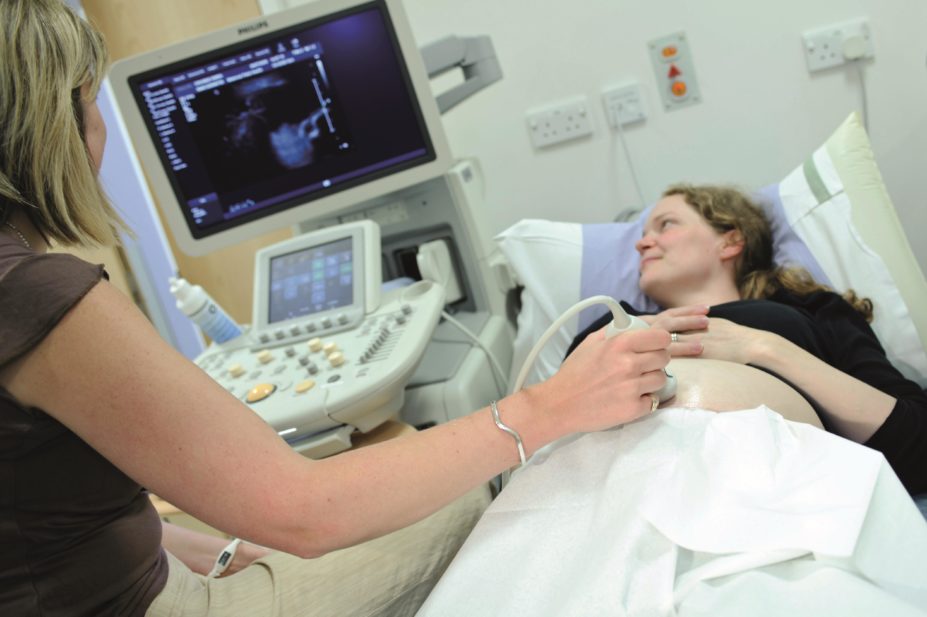
wunkley / Alamy
In this article you will learn:
- The physiological changes associated with pregnancy
- Factors to consider when prescribing in pregnancy
- Complications of pregnancy and treatment
Birth
rates vary considerably around the world, from eight to ten live births per 1,000 population per year in developed countries, to over 40 births per 1,000 population in the developing world
[1]
. In the UK, there has been a decrease in both maternal and perinatal mortality in the UK, suggesting improved antenatal care. In 2013, the mortality rate in England was 7.3 infants per 1,000 births; this equates to around 1,000 fewer deaths compared with 2003 despite a 12% increase in birth rate
[2],[3]
.
Pregnancy is the period of foetal development. It lasts around 40 weeks, measured from the first day of the last menstrual period. It is typically divided into three trimesters. The first starts with conception and runs to week 12; the second spans weeks 13 to 28; and the third from week 29 to term; historically defined as any time from week 37 to 42[4],[5]
. Each of these trimesters are characterised by distinct periods of foetal development and growth, all of which are vulnerable to disruption or harm following drug exposure.
Organogenesis of the foetus, or the formation of organs and their systems, occurs in the first trimester from fertilisation to week eight (the embryonic period). By week four, the placenta and umbilicus are in place and continue to develop until the end of the third month, in order to provide a source of nutrition and oxygen to the foetus. The embryonic period is followed by the foetal period, during which time the organs formed over the previous eight weeks grow to resemble their final forms.
The need for drug therapy during pregnancy may arise from pre-existing medical conditions or as a result of pregnancy-related complications such as diabetes, pre-eclampsia and venous thromboembolism (VTE). As all drugs have the potential to cause harm in pregnancy, any decisions to use medication are made on a balance of risk versus benefit to the mother and the unborn foetus, with the mother, where possible, actively involved in making a fully informed choice.
Pregnancy stages and physiology
During pregnancy, physiological changes in all body systems occur to meet foetal requirements for growth and development, and later to prepare for delivery. These changes can impact on both the pharmacokinetic and pharmacodynamic effects of any medicine, potentially impacting both efficacy and toxicity.
Cardiovascular changes are present from conception, with vascular resistance decreasing by up to 40%. This leads to a decline in blood pressure until about 24 weeks’ gestation, before gradually returning to pre-pregnancy levels at term. In compensation, there is a gradual increase in heart rate and stroke volume, leading to an overall increase in cardiac output that plateaus at the end of the second trimester and increases during labour. Cardiac output declines rapidly at birth and has normalised by 24 weeks postpartum[6]
.
Haematological changes during pregnancy include an increase in plasma volume by approximately 40–50%, along with a smaller increase of 15–20% in red cell volume, leading to a reduction in overall blood viscosity[6]
. Changes in the coagulation cascade also occur during pregnancy, which lead to an increase in coagulation factors (e.g. VII, VIII, IX, X and XII, fibrinogen and von Willibrand factor) and decrease in fibrinolysis through increased levels of plasminogen activator inhibitors, in order to minimise blood loss at the time of delivery[6]
. This leads to an increased risk of VTE.
Respiratory changes are mediated, likely through progesterone, in order to meet increased maternal and foetal oxygen demand. There is a significant increase in oxygen consumption and a 40% increase in ventilation, which is caused by a rise in tidal volume rather than respiratory rate. The increase in tidal volume reduces the partial pressure of carbon dioxide (PCO2) in the mother to half that of the foetus to aid with gas exchange. At the same time, progesterone acts to loosen the ligaments between ribs, enabling the chest to flare and thereby compensating the loss in chest volume as the uterus expands upwards[6]
.
Renal changes (caused by increased blood volume) lead to an increase in renal blood flow of 35–60% and glomerular filtration rate of 40–50% by the end of the first trimester. Renally cleared drugs have the potential to be excreted more rapidly. There are also changes to the renin-angiotensin system leading to fluid and sodium retention, likely triggered to compensate for the reduction in vascular resistance. Glucose loss through the kidneys is increased during pregnancy, leading to an increase in the risk of urinary tract infections and making urinalysis a less reliable indicator for gestational diabetes (see below)[6]
.
Hepatic changes during pregnancy include a decrease in serum albumin levels and altered activity of hepatic enzymes involved in drug metabolism. By the time of the delivery, albumin levels have reduced to 70–80% of normal levels, which can impact on drug levels of highly protein-bound drugs, although in clinical practice this is more likely an issue with drugs that are extensively metabolised by the liver[7]
. When monitoring blood levels of highly protein-bound drugs, they should be adjusted for low albumin levels.
Gastrointestinal changes are related to the smooth muscle effects of progesterone and increased pressure from the expanding uterus, which leads to decreased lower oesophageal sphincter muscle pressure and gastrointestinal motility[6]
. As a result, pregnant women are more prone to bloating, constipation and oesophageal reflux. There is also a theoretical risk of altered absorption as a result of changes in gastric pH and motility, although there is no evidence of this in clinical practice[7]
.
Prescribing in pregnancy
Medicines taken during pregnancy have the potential to do harm to both the foetus and the mother. They may also display unpredictable efficacy because of altered handling compared with medication taken outside of pregnancy (see ‘The effects of pregnancy on pharmacokinetics/pharmacodynamics’).
| The effects of pregnancy on pharmacokinetics/ pharmacodynamics | ||
|---|---|---|
| Effects | Drugs affected (levels change) | |
| Absorption | Reduced gastrointestinal motility Increased gastric pH | None known |
| Distribution | Increased volume of distribution Decreased albumin | Sodium valproate (↓) |
| Metabolism | Altered liver enzyme activity (cytochrome 450s and UGT) | Metoprolol (↓), phenytoin (third trimester) (↓), morphine (↓), lamotrigine (↓), caffeine (↑) |
| Excretion | Increased renal secretion peaking in second trimester | beta-lactams (↓), Low molecular weight heparins (↓), aminoglycosides (↓) |
Any decision to use drug therapy should, where possible, be made in collaboration with the mother, ensuring that she is informed of any known risks or benefits of both taking and not taking the medication.
Where drug therapy is deemed necessary, the chosen therapy should be the least likely to cause harm, used at the lowest possible dose; taking into consideration maternal, foetal and drug factors (see ‘Factors to consider when prescribing in pregnancy’). In some instances, it may be feasible to withhold treatment at certain times (e.g. in the first trimester during organogenesis to reduce the risk of congenital abnormalities, or prior to delivery to avoid the problem of withdrawal).
| Factors to consider when prescribing in pregnancy | ||
|---|---|---|
| Maternal factors | Foetal factors | Drug factors |
| Implications of not taking the drug Maternal choice Gestation Comorbidities
| Risk of congenital malformations (especially weeks one to eight) Risk of organ toxicity (e.g. renal toxicity) Withdrawal postpartum
| Altered absorption, distribution, metabolism, excretion Narrow therapeutic index Safer alternative Ability to cross placenta Topical versus systemic Adverse effects |
Any woman known to have been exposed to a known or potential teratogen (see ‘Examples of drugs known to be teratogenic’) during pregnancy will require referral to an obstetrician for further management. This may involve more intense monitoring with additional scans to identify any possible congenital malformations.
| Examples of drugs known to be teratogenic | |
|---|---|
| Drug | Teratogenic effect |
| Anticonvulsants | Microcephaly, major malformations |
| Sodium valproate | Spina bifida |
| Retinoic acid, isotretinoin | Intellectual disability |
| Thalidomide | Phocomelia |
| Warfarin | Chondrodysplasia punctate |
| Methotrexate | Severe malformations (e.g. cranial defects) |
| Lithium | Cardiac anomalies |
Pregnancy complications
During pregnancy, changes in physiology can precipitate a number of complications which, if left untreated, may be detrimental to the mother or the unborn child. Antenatal checks are essential to detect potential complications early, thus enabling optimal management and reducing the risk of morbidity and mortality.
Hyperemesis (nausea and vomiting) in pregnancy usually starts in the first trimester and tends to resolve by week 20, but may continue beyond this. It affects about 70% of women[8]
. Only around 1% experience hyperemesis gravidarum[1]
, typically defined as severe nausea and vomiting, which can result in significant dehydration, weight loss or ketonuria and often leading to hospitalisation. The aetiology of this nausea and vomiting, although not fully understood, is likely to be multifactorial, resulting from a combination of physiological, psychological and social factors[9]
.
In general, those most at risk of nausea and vomiting tend to be young, primiparous, non-smokers from low socioeconomic backgrounds. Physiological changes in pregnancy, such as raised human chorionic gonadotropin (hCG) levels and transient hyperthyroidism, have been associated with nausea and vomiting[10]
; however, where symptoms persist, other causes such as infections (e.g. urinary tract infection) or gynaecological pathologies (e.g. ovarian cysts) should be excluded.
Management of nausea and vomiting is preferred through non-pharmacological measures, such as eating smaller meals more frequently, avoiding spicy foods and caffeine, preventing fatigue and ensuring women have access to appropriate emotional support. Some women may benefit from non-pharmacological treatments such as acupressure (P6) wrist bands or the use of ginger, although evidence of their efficacy is limited[11]
.
In more severe cases, pharmacological management may be necessary. In general, the preferred first-line drug therapy is with an antihistamine such as promethazine (25mg at night) or cyclizine (50mg three times a day orally, intramuscularly or intravenously). Second-line treatment can include metoclopramide (10mg three times a day orally, intramuscularly or intravenously), ondansetron (4mg three times a day orally or intravenously) and prochlorperazine (5–10mg three times a day orally or 3mg twice a day buccally), as evidence suggests these drugs are unlikely to cause congenital malformations[12]
. In severe cases, intravenous fluids are likely to be necessary to manage dehydration. Corticosteroids should be considered as a last resort.
Supportive care should also be considered, including nutritional supplements such as folic acid 5mg daily (see below). Thiamine (25–50mg three times a day) should be taken to prevent Wernicke’s encephalopathy. This is thought to be precipitated by the use of intravenous glucose-containing fluids, and therefore is not the fluid of choice for rehydration[13]
.
Acid reflux or heartburn is common in pregnancy and affects up to 80% of women. Symptoms are primarily managed through avoidance of trigger factors, such as foods that are spicy or have a high fat content. Limiting portion sizes and avoiding tight clothing may also be beneficial, as well as stopping smoking, where relevant.
If treatment is necessary, antacids with or without an alginate should be used first-line (e.g. aluminium or magnesium containing antacids, or Gaviscon Advance (RB), which is licensed for use in pregnancy). Patients should be advised that aluminium compounds can have a constipating effect, whereas magnesium-based preparations are more likely to cause loose stools. Where these are insufficient, ranitidine (150mg twice a day) or omeprazole (20–40mg once a day) are widely used in pregnancy and are unlikely to cause harm to the foetus[14],[15]
.
Anaemia, particularly iron-deficiency anaemia, risk is increased in pregnancy because of the increase in the number of circulating red blood cells. For most women, this risk is offset by an increase in iron absorption seen in pregnancy by around three-fold[16]
. There is also an increased demand for folic acid and vitamin B12, although deficiency is less common. Women should be advised to eat a diet rich in essential vitamins and iron, and where necessary supplemented, particularly when their diet is felt to be lacking or there is evidence of deficiency (e.g. vegans)[17]
.
Folic acid deficiency is associated with an increased risk of neural tube defects, in particular spina bifida, and therefore all women trying to conceive are advised to take folic acid 400µg daily from pre-conception to the end of the first trimester[18]
. For women at increased risk of deficiency, including those on anti-folate drug therapy (e.g. anti-epileptics), a higher dose of 5mg daily is recommended.
In the UK, iron supplements should only be taken in women with iron deficiency[19]
, usually as ferrous sulphate 200mg or ferrous fumarate 210mg, ideally taken twice daily (as opposed to three times daily), as this is less likely to cause gastrointestinal disturbances, particularly constipation.
Hypertension and pre-eclampsia remain one of the greatest causes of maternal and perinatal mortality and morbidity worldwide[20]
. Normally in pregnancy there is an initial decline in blood pressure that gradually increases to pre-pregnant levels later on. However, there is an increasing tendency for raised blood pressure during pregnancy.
Pregnancy-induced hypertension (PIH) is an increase in blood pressure above a threshold of 140/90mmHg that occurs beyond 20 weeks gestation and resolves on delivery. PIH occurs in around 10% of pregnancies[18]
. Pre-eclampsia, defined as hypertension accompanied by pregnancy-induced proteinuria, affects 2–8% of pregnancies worldwide[20]
. In severe cases, this can lead to convulsions or eclampsia. Pregnant women should have their blood pressure monitored at each antenatal check-up, as well as having their urine dipped to test for protein, to enable early detection of PIH and pre-eclampsia.
Women at risk of pre-eclampsia should be advised to take a daily dose of aspirin (75mg) from 12 weeks of pregnancy[21]
. This includes women with any of the following risk factors:
- hypertensive disease during a previous pregnancy
-
chronic kidney disease - autoimmune disease (e.g. systemic lupus erythematosis or antiphospholipid syndrome)
- type 1 or type 2 diabetes
- chronic hypertension
- More than one of: first pregnancy, aged 40 or older, pregnancy interval of more than 10 years, BMI of 35 or more, family history of pre-eclampsia, multiple pregnancy.
ACE inhibitors and angiotensin-II receptor antagonists should be avoided in pregnancy, as treatment can lead to oligohydramnios (reduced amniotic fluid) and theoretically adversely affect neonatal renal function. Labetalol is the drug treatment of choice for hypertension in pregnancy, followed by nifedipine and methyldopa. Treatment should be initiated in hospital in severe cases.
Doses of antihypertensives are titrated to achieve the desired effect and women are closely monitored throughout pregnancy and in the period postpartum, at which point blood pressure usually returns to normal within a couple of weeks. For breastfeeding women who require continued treatment postpartum, antihypertensives known to be unlikely to cause harm include labetalol, nifedipine, atenolol, enalapril, captopril and metoprolol; the safety for amlodipine, angiotensin-II receptor antagonists and other ACE inhibitors has not yet been established[21]
.
Gestational diabetes
incidence in pregnancy, as with hypertension, is increasing year on year in the UK[22]
, linked to the increased incidence of obesity. Gestational diabetes occurs in about 5% of pregnancies[22]
. Gestational diabetes is a state of hyperglycaemia (a fasting glucose level of 5.6mmol/L or more) triggered by pregnancy that usually resolves following delivery. However, it can persist and is likely to recur with subsequent pregnancies. At each routine antenatal check, women will have their urine dipped to test for glucose to ensure early detection. Untreated gestational diabetes increases the risk of perinatal complications such as excessive foetal growth, induction of labour, caesarean section, pre-eclampsia, premature birth and neonatal hypoglycaemia at birth[23]
.
Women should be advised to make modifications to their lifestyle and diet. However, if this is unsuccessful in achieving a fasting glucose of less than 5.3mmol/L, pharmacological treatment should be started as soon as possible to avoid complications. Oral metformin can be used as first-line option to manage women with gestational diabetes, either alone or as adjunct to insulin[22]
. Treatment with insulin is recommended if oral treatment is unsuccessful, blood glucose levels are significantly raised or if metformin is unsuitable. Women with gestational diabetes require additional antenatal appointments to assess glycaemic control and compications[22]
. These should be continued postpartum, when treatment in most cases can be discontinued.
VTE risk increases with pregnancy because of altered homeostasis and increased circulating blood volume[19]
. Although rare, VTE is one of the most common causes of maternal mortality in the developed world; the risk is increased in the presence of pre-existing risk factors such as clotting disorders, obesity, a positive family history and smoking[24]
.
Women should have a VTE assessment in early pregnancy, typically carried out at the booking appointment with the midwife, to establish all risk factors (see ‘Risk factors for VTE’), and repeated when her situation changes (e.g. with intercurrent illness or hospitalisation)[24]
,
[25]
. If the woman is considered to be at increased risk, prophylaxis should be initiated with a low molecular weight heparin (LMWH)[25]
. For some women, treatment may need to continue throughout pregnancy, whereas other women will only require it in the presence of transient risk factors (e.g. hyperemesis gravidarum) or a severe infection requiring hospitalisation.
VTE assessment is repeated postnatally, as risk factors associated with delivery (e.g. caesarean section, excessive postpartum haemorrhage) may trigger the need for prophylactic treatment. In most cases, postnatal prophylaxis is continued for a period of seven days, except in high-risk women, where up to six weeks of treatment may be required[25]
.
| Risk factors for VTE |
|---|
|
In women suspected of having a VTE during pregnancy, treatment with a LMWH is initiated immediately, unless contraindicated (i.e. those at high risk of bleeding or in the case of known allergies), while investigations are carried out. Injections are administered twice daily, as increased renal flow leads to more rapid elimination, advocating more frequent dosing. Treatment is continued throughout pregnancy and for at least six weeks postpartum, for a minimum total duration of three months. Postnatally, the dosing schedule can be changed to once daily. LMWHs are considered safe in breastfeeding[25]
because of their poor oral bioavailability and likely inactivation in the infant’s stomach. Warfarin is generally reserved only for postnatal use, as it is safe to take when breastfeeding and women may be switched to oral treatment for extended postnatal courses. The novel oral anticoagulants (e.g. dabigatran, rivaroxaban) are not currently recommended for use in pregnancy or during breastfeeding.
Obstetric cholestasis has a worldwide incidence of 0.7%, although this varies with ethnic groups, genetics and environmental factors[26]
. Patients typically present with pruritus, in the absence of a rash or any other possible cause, and on investigation will have abnormally raised liver function tests (LFTs). Primary management is to exclude any other possible cause, followed by frequent monitoring of LFTs and the pregnancy on account of the increased risk of premature birth and stillbirth.
Treatment with ursodeoxycholic acid helps displace bile salts and increase their rate of clearance. Antihistamines, such as chlorphenamine, may be prescribed to help relieve itching, and can be used as a sedative in patients with pruritus that interrupts their sleep. Cholestasis affects vitamin K absorption and may increase the patient’s international normalised ratio. These patients should be treated with a vitamin K supplement, ideally menadiol[27]
.
- This article was amended on 7 August 2015 to state that aspirin (75mg) should be given from 12 weeks in pregnancy in some women to reduce the risk of pre-eclampsia, not for the first 12 weeks as originally stated.
Nicola Hill is a pharmacy team leader at Portsmouth Hospitals NHS Trust.
Elaine Smith is lead directorate pharmacist at Chelsea and Westminster Foundation Trust and UCL School of Pharmacy.
How to have effective consultations on contraception in pharmacy
What benefits do long-acting reversible contraceptives offer compared with other available methods?
Community pharmacists can use this summary of the available devices to address misconceptions & provide effective counselling.
Content supported by Bayer
References
[1] World Health Organization. Facts and figures from The World Health Report 2005.
[2] Mothers and Babies: Reducing Risk through Audits and Confidential Enquiries across the UK (MBRRACE): Perinatal Mortality Surveillance Report (June 2015).
[3] Mothers and Babies: Reducing Risk through Audits and Confidential Enquiries across the UK (MBRRACE): Saving Lives, Improving Mothers’ Care (December 2014).
[4] The American Congress of Obstetricians and Gynecologists (ACOG) Committee opinion: Definition of term pregnancy (November 2013).
[5] Spong CY. Defining “term” pregnancy: recommendations from the Defining “Term” Pregnancy Workgroup. JAMA 2013;(309):2445–2446.
[6] Carlin A & Alfirevic Z. Physiological changes of pregnancy and monitoring Best Practice & Research. Clinical Obstetrics and Gynaecology 2008;22(5):801–823.
[7] Anderson GA. Pregnancy-Induced Changes in Pharmacokinetics: A Mechanistic based approach. Clin Pharmacokinet 2005;44(10):989–1008.
[8] Einarson TR, Piwko C & Koren G. Quantifying the global rates of nausea and vomiting of pregnancy: a meta analysis. Journal of the Population Therapeutics and Clinical Pharmacology [Journal de la Therapeutique des Populations et de la Pharmacologie Clinique] 2013;20(2):e171–183.
[9] Goodwin TM. Nausea and vomiting of pregnancy: an obstetric syndrome. American Journal of Obstetrics and Gynecology 2002;186(5 Suppl):S184–S189.
[10] Tareen AK, Baseer A, Jaffry HF et al. Thyroid hormone in hyperemesis gravidarum. J Obstet Gynaecol 1995;21(5):497–501.
[11] Matthews A, Haas DM, O’Mathuna DP et al. Interventions for nausea and vomiting in early pregnancy (Review). Cochrane Collaboration 2014.
[12] UK Teratology Information Service (UKTIS). Treatment of nausea and vomiting in pregnancy. TOXBASE. 2012.
[13] Schabelman E & Kuo D. Glucose before thiamine for Wernicke’s encephalopathy. A literature review. The Journal of Emergency Medicine 2012;42(4): 488–494.
[14] The National Institute for Health and Care Excellence. Clinical Knowledge Summaries (CKS): Dyspepsia Pregnancy-Associated (Dec 2012) Available at: http://cks.nice.org.uk/dyspepsia-pregnancy-associated#!scenario (accessed June 2015).
[15] Pasternak B & Hviid A. Use of proton-pump inhibitors in early pregnancy and the risk of birth defects. N Engl J Med 2010;363:2114–2123.
[16] Pavord S, Myers B, Robinson S et al. (2011): UK guidelines on the management of iron deficiency anaemia in pregnancy – BSCH. Available at: http://www.bcshguidelines.com/documents/UK_Guidelines_iron_deficiency_in_pregnancy.pdf (accessed June 2015).
[17] The Department of Health. The Pregnancy Book (2011).
[18] The National Institute for Health and Care Excellence. Clinical Guidance 62 Antenatal Care (2014).
[19] Lussana F, Coppens M, Cattaneo M et al. Pregnancy-related venous thromboembolism: Risk and the effect of thromboprophylaxis. Thrombosis Research 2012;129:673–680.
[20] World Health Organization International Collaborative Study of Hypertensive Disorders in Pregnancy. Geographic variation in the incidence of hypertension in pregnancy. American Journal of Obstetrics and Gynecology 1988;158:80–83.
[21] The National Institute for Health and Care Excellence. Clinical Guidance 107. Hypertension in pregnancy: the management of hypertensive disorders during pregnancy. Issued: August 2010. Last modified: January 2011.
[22] The National Institute for Health and Care Excellence. NG3 Diabetes in pregnancy: management of diabetes and its complications from preconception to the postnatal period (February 2015).
[23] Hunt KF, Whitelaw BC & Gayle C. Gestational diabetes. Obstetrics, Gynaecology and Reproductive Medicine 2014;24:8 238–244.
[24] Reducing the risk of venous thromboembolism during pregnancy and the puerperium: Greentop Guideline 37a (April 2015).
[25] The National Institute for Health and Care Excellence. Clinical Guideline 92: Reducing the risk (2010).
[26] Kenyon AP, Tribe RM, Nelson-Piercy C et al. Pruritus in pregnancy: a study of anatomical distribution and prevalence in relation to the development of obstetric cholestasis. Obstet Med 2010;3:25–29.
[27] Obstetric Cholestasis Green–top Guideline 43 (April 2011).


